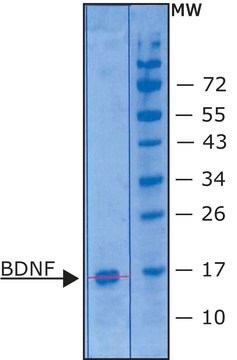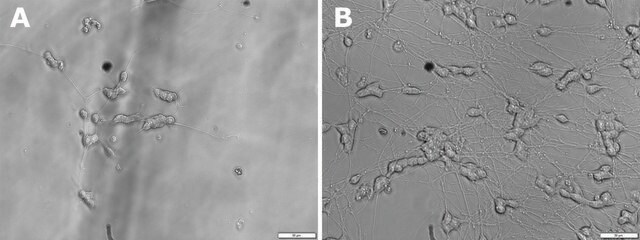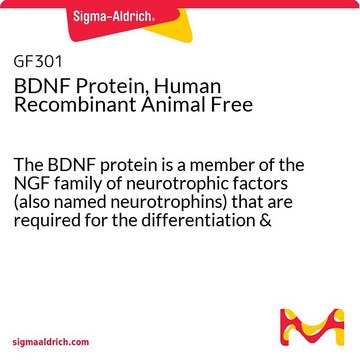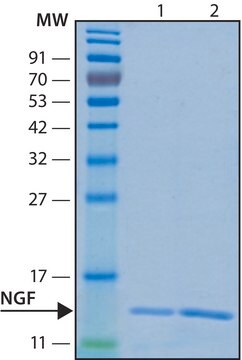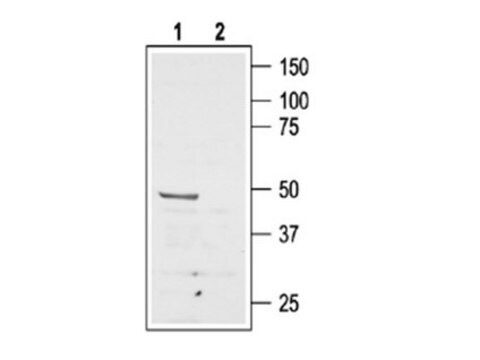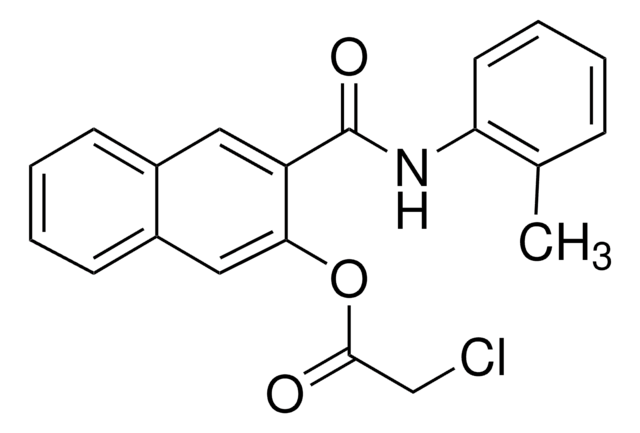GF029
Brain Derived Neurotrophic Factor, recombinant
Faça loginpara ver os preços organizacionais e de contrato
About This Item
Código UNSPSC:
12352200
eCl@ss:
32160405
NACRES:
NA.28
Produtos recomendados
Descrição geral
FUNCTION: SwissProt: P23560 # Promotes the survival of neuronal populations that are all located either in the central nervous system or directly connected to it. Major regulator of synaptic transmission and plasticity at adult synapses in many regions of the CNS. The versatility of BDNF is emphasized by its contribution to a range of adaptive neuronal responses including long-term potentiation (LTP), long-term depression (LTD), certain forms of short-term synaptic plasticity, as well as homeostatic regulation of intrinsic neuronal excitability.
SIZE: 247 amino acids; 27818 Da
SUBUNIT: Monomers and homodimers. Binds to NTRK2/TRKB.
SUBCELLULAR LOCATION: Secreted.
PTM: The propeptide is N-glycosylated and glycosulfated. & Converted into mature BDNF by plasmin (PLG) (By similarity).
DISEASE: SwissProt: P23560 # Defects in BDNF are a cause of congenital central hypoventilation syndrome (CCHS) [MIM:209880]; also known as congenital failure of autonomic control or Ondine curse. CCHS is a rare disorder characterized by abnormal control of respiration in the absence of neuromuscular or lung disease, or an identifiable brain stem lesion. A deficiency in autonomic control of respiration results in inadequate or negligible ventilatory and arousal responses to hypercapnia and hypoxemia. CCHS is frequently complicated with neurocristopathies such as Hirschsprung disease that occurs in about 16% of CCHS cases.
SIMILARITY: SwissProt: P23560 ## Belongs to the NGF-beta family.
SIZE: 247 amino acids; 27818 Da
SUBUNIT: Monomers and homodimers. Binds to NTRK2/TRKB.
SUBCELLULAR LOCATION: Secreted.
PTM: The propeptide is N-glycosylated and glycosulfated. & Converted into mature BDNF by plasmin (PLG) (By similarity).
DISEASE: SwissProt: P23560 # Defects in BDNF are a cause of congenital central hypoventilation syndrome (CCHS) [MIM:209880]; also known as congenital failure of autonomic control or Ondine curse. CCHS is a rare disorder characterized by abnormal control of respiration in the absence of neuromuscular or lung disease, or an identifiable brain stem lesion. A deficiency in autonomic control of respiration results in inadequate or negligible ventilatory and arousal responses to hypercapnia and hypoxemia. CCHS is frequently complicated with neurocristopathies such as Hirschsprung disease that occurs in about 16% of CCHS cases.
SIMILARITY: SwissProt: P23560 ## Belongs to the NGF-beta family.
Aplicação
Concentration range for most in vitro applications is 0.5 to 100 ng/mL. Responding cells are (partial list): Nerve, glial cells.
forma física
Sterile filtered, lyophilized with no additives.
Armazenamento e estabilidade
The lyophilized powder, though stable at room temperature, is best stored desiccated below 0°C. Reconstitute in water to a concentration of 0.1-1.0 mg/mL. This solution can be diluted into water or other buffered solutions. Reconstituted BDNF should be stored in undiluted aliquots at -20°C for up to six months. Avoid repeated freeze/thaw cycles.
Exoneração de responsabilidade
Unless otherwise stated in our catalog or other company documentation accompanying the product(s), our products are intended for research use only and are not to be used for any other purpose, which includes but is not limited to, unauthorized commercial uses, in vitro diagnostic uses, ex vivo or in vivo therapeutic uses or any type of consumption or application to humans or animals.
Código de classe de armazenamento
11 - Combustible Solids
Classe de risco de água (WGK)
WGK 1
Ponto de fulgor (°F)
Not applicable
Ponto de fulgor (°C)
Not applicable
Certificados de análise (COA)
Busque Certificados de análise (COA) digitando o Número do Lote do produto. Os números de lote e remessa podem ser encontrados no rótulo de um produto após a palavra “Lot” ou “Batch”.
Já possui este produto?
Encontre a documentação dos produtos que você adquiriu recentemente na biblioteca de documentos.
Nossa equipe de cientistas tem experiência em todas as áreas de pesquisa, incluindo Life Sciences, ciência de materiais, síntese química, cromatografia, química analítica e muitas outras.
Entre em contato com a assistência técnica